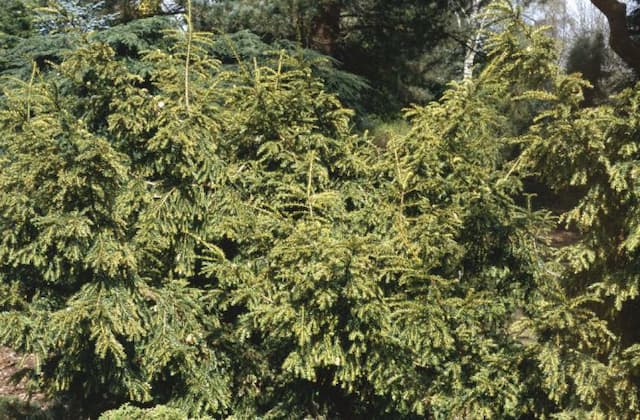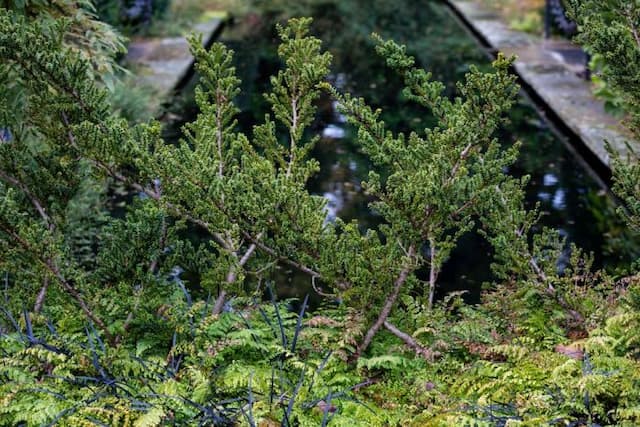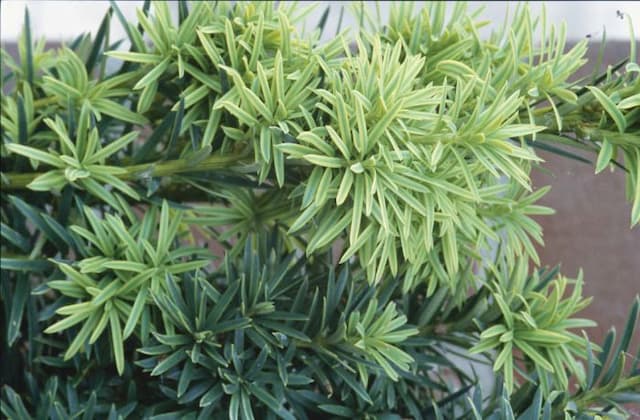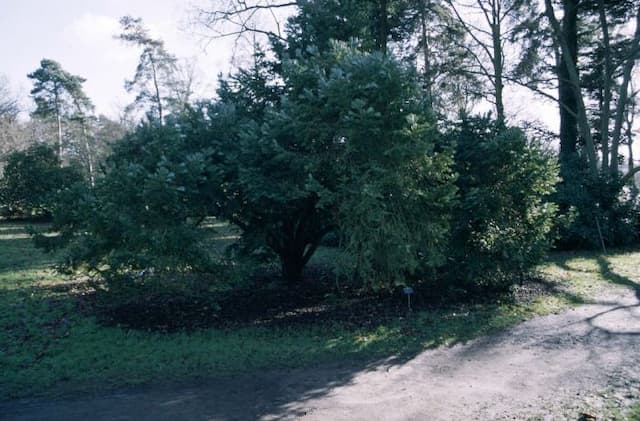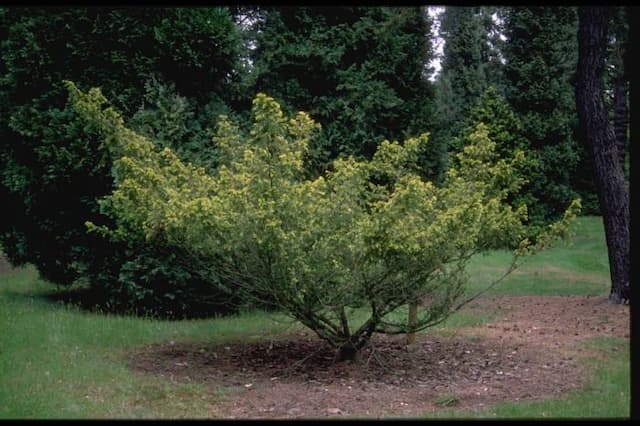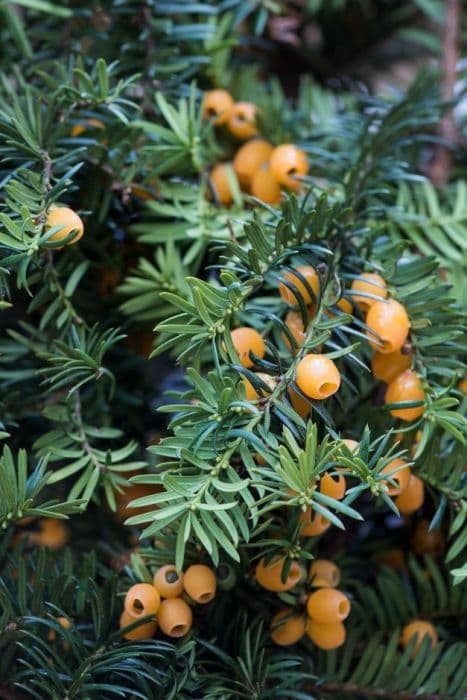English Yew Taxus baccata 'Icicle'

ABOUT
Taxus baccata 'Icicle', commonly known as the English yew 'Icicle', is a striking evergreen conifer that is characterized by its distinctive foliage and ornamental features. It is cultivated for its aesthetic appeal and commonly found in garden landscapes. The English yew 'Icicle' has a narrow, upright growth habit, presenting a columnar form that lends itself to elegant garden designs. Its leaves are needle-like, with a soft texture, arranged spirally on the branches, though they appear to spread outwards in two ranks. The needles boast a dark green color on the upper side and are lighter underneath, creating a subtle two-tone effect that becomes more profound with new growth. During the spring season, this yew variety produces inconspicuous flowers, which, depending on the plant, could be either pollen-bearing or seed-bearing. These flowers are usually small and not showy, often overlooked in the garden. Following the flowering period, the plant may bear decorative red berries. These berries hold a visually pleasing contrast against the dark foliage, adding to the ornamental value of the yew. However, they are also toxic if ingested. The 'Icicle' is appreciated for its year-round beauty, as it adds color and form to the garden even in the coldest months. With its refined appearance and evergreen nature, Taxus baccata 'Icicle' is a favored choice for hedges, formal gardens, and as a specimen plant in varied landscaping projects.
About this plant
 Names
NamesFamily
Taxaceae.
Synonyms
Icicle Yew, English Yew 'Icicle'.
Common names
Taxus baccata 'Icicle'.
 Toxicity
ToxicityTo humans
Yew, specifically Taxus baccata 'Icicle', is highly toxic to humans. All parts of the plant contain toxic alkaloids, with the exception of the flesh of the berry. The most potent compound found within yew is taxine, a mixture of alkaloids which can cause a rapid heartbeat (tachycardia) or can slow it down (bradycardia) leading to cardiac arrest. Symptoms of yew poisoning may include dizziness, dry mouth, dilated pupils, weakness, and an irregular heartbeat. Ingesting any parts of the plant can potentially lead to convulsions, coma, and even death due to cardiac failure. Extreme caution should be taken to ensure that no parts of the plant are consumed.
To pets
Yew, specifically Taxus baccata 'Icicle', is also highly toxic to pets. The plant contains alkaloids such as taxine which can interfere with the heart's function. Symptoms of yew poisoning in pets include vomiting, diarrhea, difficulty breathing, tremors, lethargy, seizures, and potentially life-threatening changes in heart rate. Consuming even a small amount of any part of the plant (except the berry flesh) can result in acute cardiac failure and death. Immediate veterinary attention is required if a pet ingests any part of a yew plant.
 Characteristics
CharacteristicsLife cycle
Perennials
Foliage type
Evergreen
Color of leaves
Green
Height
6-10 feet (1.8-3 meters)
Spread
3-6 feet (0.9-1.8 meters)
Plant type
Shrub
Hardiness zones
6-7
Native area
Europe
Benefits
 General Benefits
General Benefits- Ornamental Appeal: Taxus baccata 'Icicle', commonly known as the English Yew, has a distinctive narrow upright form with bright green foliage that provides visual interest and contrast in the landscape.
- Evergreen Nature: The English Yew retains its foliage throughout the year, providing continuous color and structure in gardens even during the colder months.
- Low Maintenance: This plant requires minimal care once established, making it suitable for gardeners who prefer low-maintenance landscaping.
- Drought Tolerance: Once established, the English Yew can withstand periods of drought, reducing the need for constant watering.
- Shade Tolerance: It is capable of growing well in shaded areas, where other plants might struggle, making it versatile for different garden locations.
- Wildlife Habitat: The dense foliage can provide shelter and nesting sites for birds.
- Privacy Screen: Due to its dense growth habit, the English Yew can serve as an effective natural privacy barrier or hedge.
- Soil Adaptability: The plant can adapt to a range of soil types, provided the soil is well-drained.
- Longevity: English Yews are known for their long lifespan, often living for hundreds of years, which can add a sense of permanence and history to a garden.
 Medical Properties
Medical Properties- Paclitaxel production: The European yew's bark, needles, and twigs contain precursors for the drug paclitaxel (common name: Taxol), which is used in the treatment of various cancers, such as ovarian and breast cancer.
- Antitumor activity: Extracts from the yew have been researched for their potential to inhibit the growth of cancer cells due to naturally occurring compounds known as taxanes.
 Air-purifying Qualities
Air-purifying QualitiesThis plant is not specifically known for air purifying qualities.
 Other Uses
Other Uses- Woodturning: The dense, fine grain of Yew wood makes it suitable for woodturning projects, such as creating decorative bowls or intricate wooden art pieces.
- Furniture Making: Due to its durability and attractive appearance, Yew wood is often used in crafting high-quality furniture items like cabinets and tables.
- Veneer Production: Yew wood can be sliced into thin decorative veneers used in marquetry and paneling, providing a rich and decorative finish to various surfaces.
- Garden Design: With its slow growth and tolerance to pruning, Taxus baccata 'Icicle' can be shaped into topiaries or hedges to structure and enhance a garden's aesthetic.
- Dye Production: The bark of the Yew can be processed to extract tannins, which were traditionally used to create dyes for textiles.
- Archery Bow Making: Historically, Yew wood's balance between flexibility and strength made it an ideal material for crafting traditional longbows.
- Folklore and Tradition: Due to its longstanding presence and symbolic value, Yew is sometimes incorporated into cultural ceremonies or planted in sacred places.
- Tool Handles: The strength of Yew wood is well-suited for making durable handles for various hand tools, including chisels and hammers.
- Musical Instruments: The resonant properties of Yew allow for its use in making parts of musical instruments, such as the bodies of certain string instruments.
- Wildlife Support: The dense foliage of the Yew can provide shelter and breeding spaces for birds, and the berries are a source of food for certain bird species, though they are toxic to humans.
Interesting Facts
 Feng Shui
Feng ShuiThe English Yew is not used in Feng Shui practice.
 Zodiac Sign Compitability
Zodiac Sign CompitabilityThe English Yew is not used in astrology practice.
 Plant Symbolism
Plant Symbolism- Immortality: Commonly known as the European Yew, Taxus baccata 'Icicle' is symbolic of immortality due to its long lifespan and evergreen nature, suggesting an enduring existence beyond the mortal realm.
- Resurrection: The yew tree is often associated with resurrection or the cycle of life and death because it can easily regenerate by sprouting from cut branches and stumps.
- Protection: In ancient times, the European Yew was thought to ward off evil and was frequently planted in churchyards and sacred grounds, denoting a symbolism of protection and sanctity.
- Transcendence: Its capacity to thrive for centuries gives it a symbolic connection to the transcendence of the spiritual over the corporeal, as it seemingly surpasses temporal boundaries.
- Mystery: The yew tree carries a mystic aura, partially because of its toxic properties and its association with old pagan rituals, thus symbolizing mystery and the unknown.
 Water
WaterThe English Yew 'Icicle' should be watered deeply and infrequently, allowing the soil around to become somewhat dry between waterings. As a guideline, water approximately once a week with about 1 to 1.5 gallons during the growing season, depending on the climate and soil drainage. In periods of drought or extreme heat, you may need to water more frequently, while in cooler weather or during the dormant season, watering can be reduced. Always check the soil moisture at a depth of a couple of inches to avoid overwatering, which can lead to root rot.
 Light
LightEnglish Yew 'Icicle' prefers partial shade to full sun exposure. A spot that receives morning sunlight and is shaded in the afternoon is ideal. It can adapt to different lighting conditions but it thrives best when protected from the scorching afternoon sun, especially in hotter climates.
 Temperature
TemperatureEnglish Yew 'Icicle' is hardy and can tolerate a wide range of temperatures, from about -20°F to 120°F. The ideal temperature range for this plant is between 60°F and 70°F. Extreme temperatures can be endured for short periods, but prolonged exposure can be detrimental.
 Pruning
PruningPruning English Yew 'Icicle' is necessary to maintain its shape and remove any dead or diseased branches. The best time to prune is in late winter or early spring, before the onset of new growth. It can be pruned again lightly in the summer if necessary. Avoid heavy pruning as yews can be slow to recover.
 Cleaning
CleaningAs needed
 Soil
SoilEnglish Yew 'Icicle' thrives in moist, well-drained soil with pH ranging from slightly acidic to neutral (pH 5.5-7). A mix containing equal parts garden soil, compost, and peat or sand provides optimal conditions for root growth and health. Ensure the soil is loose to promote good drainage and prevent waterlogging, which can be detrimental to this plant.
 Repotting
RepottingEnglish Yew 'Icicle' does not need frequent repotting as it is slow-growing. Repotting every 3 to 5 years suffices, or when the plant becomes root-bound. Ideally, repot the plant in the spring before new growth starts, using fresh soil mix to replenish nutrients and encourage continued health.
 Humidity & Misting
Humidity & MistingEnglish Yew 'Icicle' is tolerant of a wide range of humidity levels, but it does best in moderate humidity. It does not require any special humidity considerations when grown outdoors. Indoor plants may benefit from occasional misting if the air is very dry, especially during winter.
 Suitable locations
Suitable locationsIndoor
Place English Yew 'Icicle' near a window with filtered light and ensure good air circulation.
Outdoor
Plant English Yew 'Icicle' in partial shade, shelter from harsh winds, and well-draining soil.
Hardiness zone
4-7 USDA
 Life cycle
Life cycleTaxus baccata 'Icicle', commonly known as the English Yew 'Icicle', begins its life cycle as a seed, often dispersed by birds that consume the fleshy aril surrounding the seed. After germination, the seedling develops into a young plant with delicate, needle-like foliage characteristic of juvenile yews. Over several years, it undergoes a vegetative growth phase, during which time it establishes a robust root system and begins to form the dense, conical shape typical of the 'Icicle' cultivar. As a mature plant, it produces small, inconspicuous male and female cones on separate trees; pollination occurs primarily by wind, and once fertilized, the female cones develop the red, berry-like arils. The English Yew 'Icicle' can then enter a long period of stability, where it continues to grow slowly, maintaining health and shape through annual cycles of foliage growth and dormancy. This slow-growing plant can live for hundreds of years, eventually reaching the end of its life cycle when it succumbs to environmental stresses, disease, or old age.
 Propogation
PropogationPropogation time
Late summer
The most popular method of propagating the English Yew 'Icicle' is through semi-hardwood cuttings. This is typically done in the late summer to early fall, when the new growth has matured and slightly hardened off. A cutting should be made from healthy, disease-free branches, ideally 6 to 8 inches (15 to 20 centimeters) long. The lower leaves are removed to expose a section of stem, which can then be dipped in a rooting hormone to encourage root growth. The prepared cutting is then placed in a well-draining potting mix, ensuring that at least a couple of nodes are buried where roots can form. To maintain a high humidity environment, you can cover the pot with a plastic bag or use a misting system. New roots typically develop within a few weeks to a couple of months, after which the new plants can be gradually acclimated to ambient conditions before being transplanted into the garden.
